
What is a Ladder Leader?
(including video below)
Originally developed for nymph fishing – a ladder leader is our new way to use old ideas to quickly change the spacing of the flies on your leader. It also means that you don’t have to re-tie your whole leader when a dropper leg becomes too short and it can help to avoid tangles by making the dropper stand out a little way from the main-stem of the leader (and even swivel around it).
Depending on which style you want to use, you can do most of the preparation at home, so that you can quickly add and remove droppers, change flies and alter spacing – even if your eyesight isn’t up to quickly threading small flies onto fine tippets.
Using a Ladder Leader for Winter Czech Nymphing
When fishing for grayling with teams of nymphs, the depth and separation of your flies can be critical to success. I’ve lost count of the times that by re-rigging my dropper fly to fish closer to the point fly has significantly increased catches. At the same time, it CAN cause fish to switch off completely.
This response varies all the time – even for the same stretch of river on the same day (never mind between different rivers and different days). But, you can only find out the ideal spacing by experimenting with different configurations every time you fish.
If you’ve ever been in that situation you’ll know how annoying it is to have to re-rig your whole tippet (or join scrappy bits of tippet-extensions) to increase the distance between point and dropper. It’s even worse with three flies, when any change to the spacing of top and middle dropper is a royal pain in the ass. Here's a video showing the benefits of solving this problem:
The session in the video above was an early trial where the ladder leader really showed its value by allowing me to stay in touch with a shoal of grayling that was moving up and down in the water while roving around in a back-eddy just off the main flow. The river was pretty high that day – and pinpoint location of fish was critical.
If you’re not already using the best-kept secrets of competition anglers’ nymphing tactics in your own leisure fishing, you can start now for free in our online tutorials.
These also include special subscriber offers on exclusive video, e-book and print book publications - so there's lots of benefits beyond the free tuition.
How the Ladder Leader was (re)Invented
Over the winter of 2019 I ended up on a crazy quest to re-create the fishing and fly tying methods of a largely forgotten Devonshire wet fly angler. I reckon the man in question, Henry Charles Cutcliffe, would have given many of today’s competition anglers a run for their money. His angling observations and fly-design concepts are bang on the money in my experience.

One of my Re-Created Cutcliffe Flies
During that quest I learned to dye hare and rabbit pelts with turmeric and alum, tracked down “purple” cows for their fur and learned to tie with eyeless hooks in-hand (without a vise). Plug alert: The full story is in my book "Fly Fishing Master H.C. Cutcliffe Rediscovered in The Art of Trout Fishing in Rapid Streams".
I was also struck by something I’d seen in two other places before, but hadn’t paid too much attention to. I’d first seen a version of it in Vladi Trzebunia’s swivelling droppers. Then I’d seen North Country Wet Fly guru Robert Smith constructing his “spider” leaders using a similar technique. When it cropped up again in Cutcliffe’s manuscript as a way to construct leaders (or “collars” as they were called in the 1800s) from gut, some cogs began to turn.
Better late than never...
The First Ladder Leader Dropper Idea
I realised that, by using the girth hitch to attach droppers (like the three anglers I just mentioned), it should make it easy to move any dropper from one stopper knot to another. In other words, if you un-picked the girth hitch a little, you could slide that dropper down to the next knot in your tippet and re-tighten it.
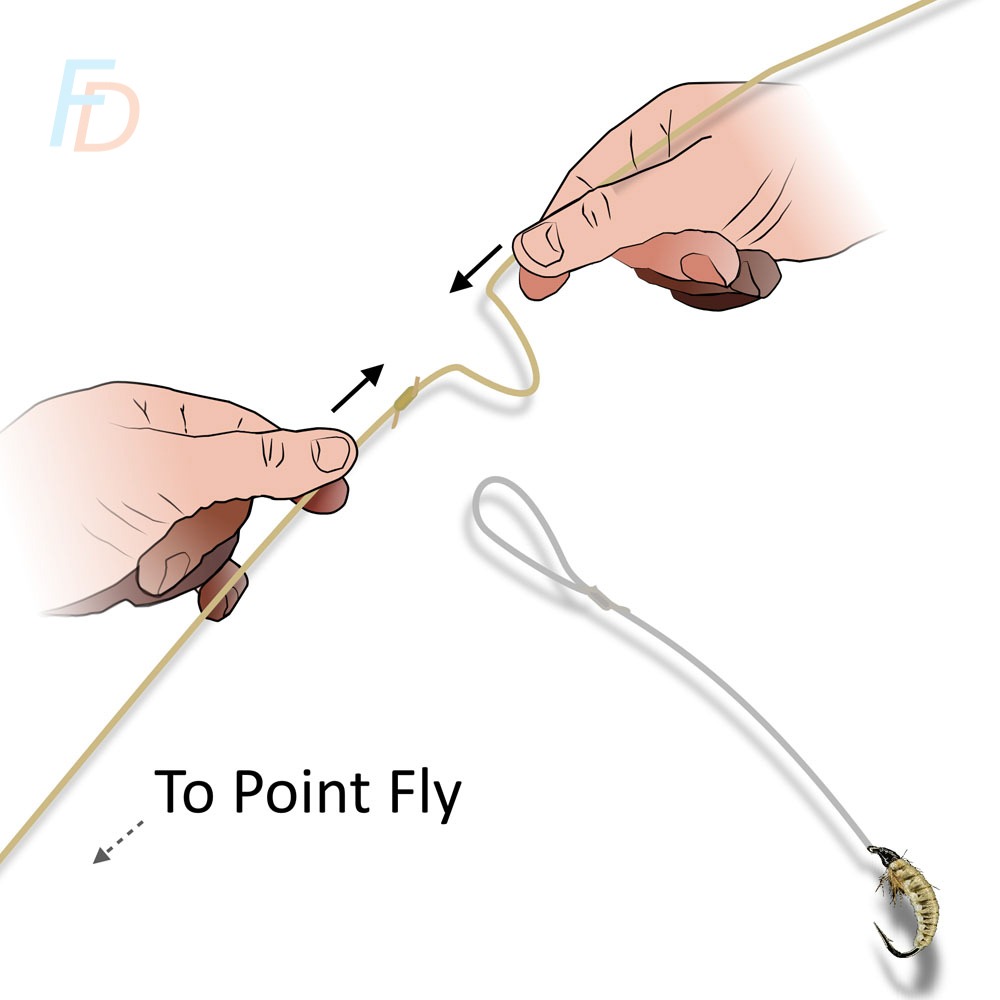
STEP 1
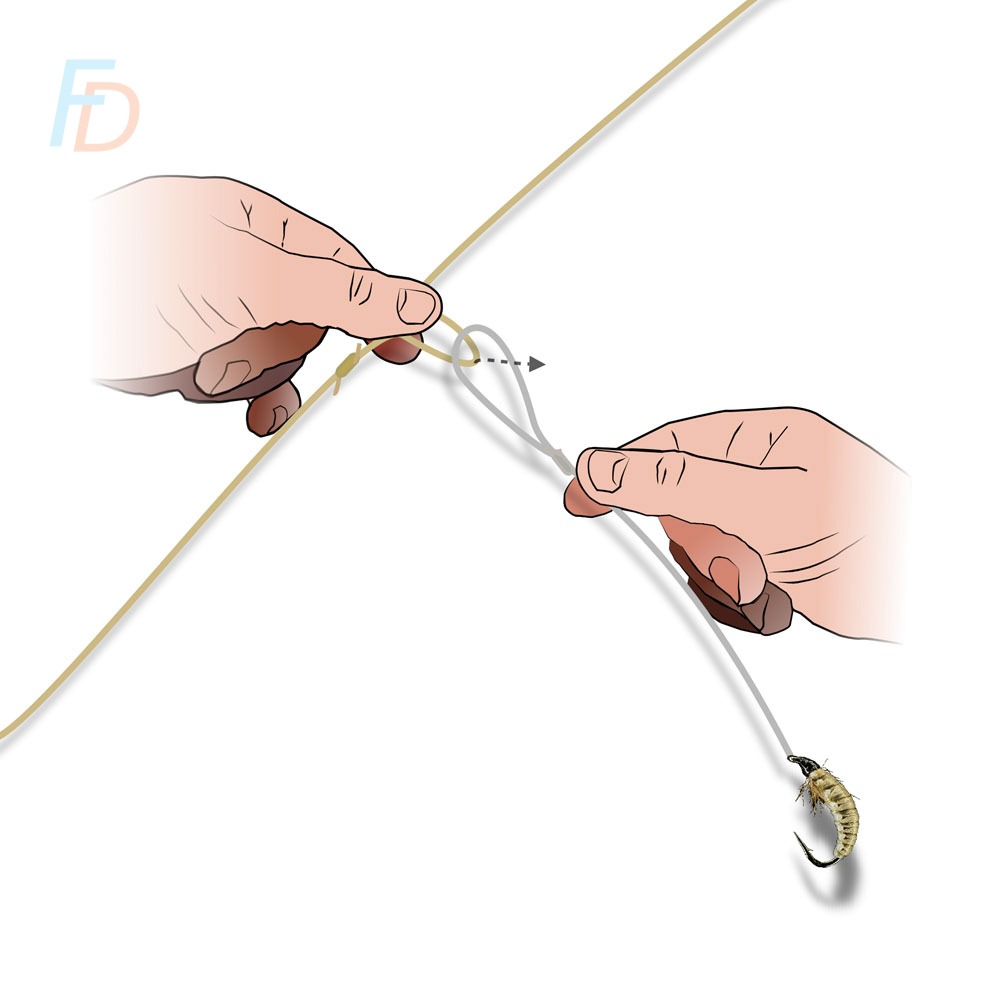
STEP 2
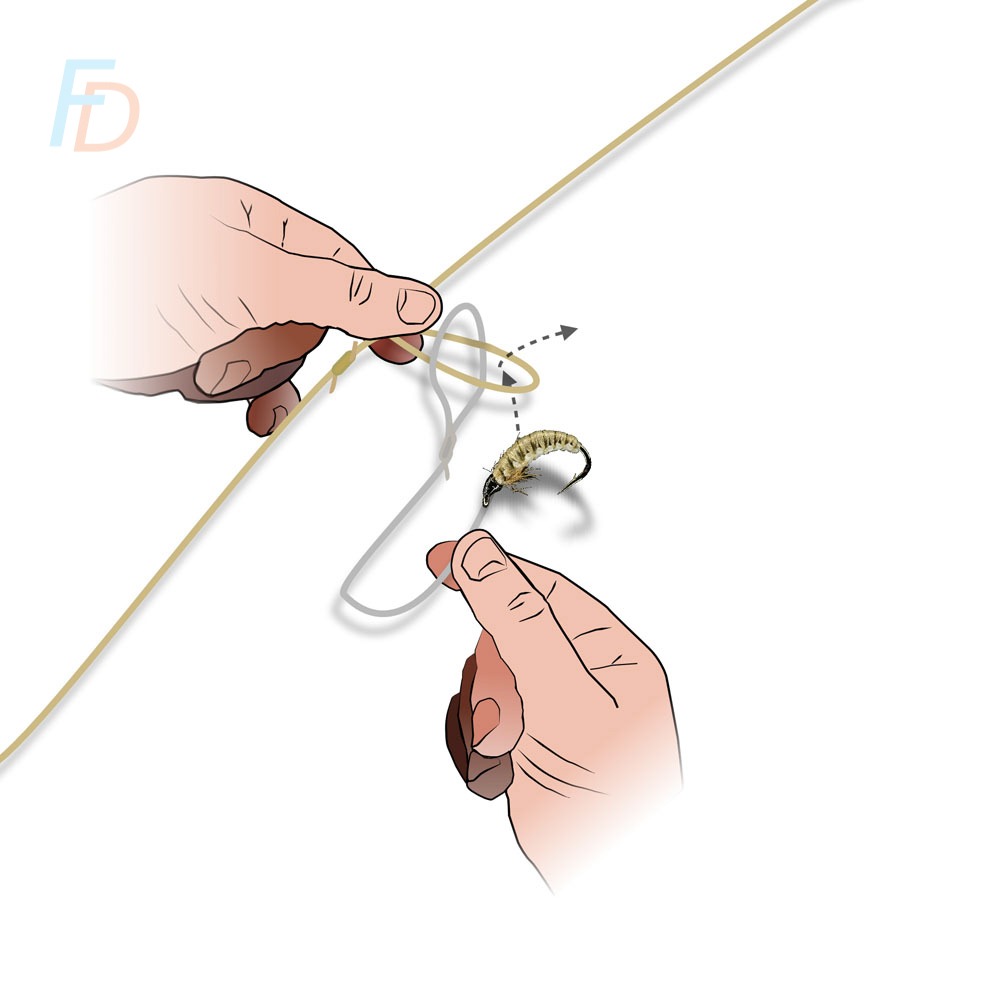
STEP 3
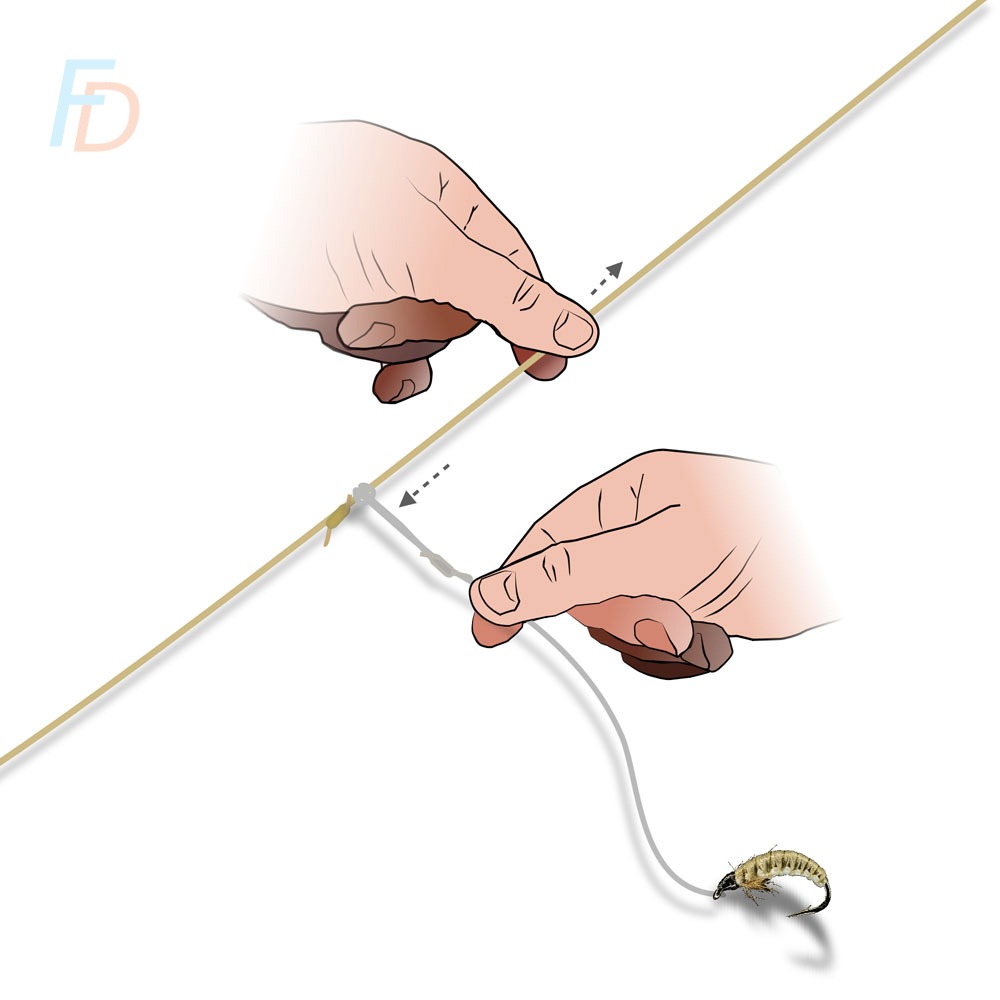
STEP 4
Being completely honest, though, I almost gave up on this moveable dropper idea. I figured that it was impractical to make the sheer number of jointed sections of tippet you’d need in order to create small enough adjustments to be useful for short-line, winter nymphing. I also didn’t fancy weakening my breaking strain from having dozens of blood knots in fine tippet.
Neither did I like the idea of having so many bulky knots throughout my leader. One thought I briefly had was to add a series of much smaller knots directly into a single strand of leader. However, I dismissed that as unworkable because I knew the effect that wind-knots tend to have on tippet breaking strain too! So how did I solve those problems?
JP to the Rescue
It was John Pearson who actually came up with a first workable answer when we were talking about this idea in a roundabout way. As we were talking about challenges I had with writing the Cutcliffe book, we touched on the potential of girth-hitching droppers. John actually independently suggested a knotted, single “main stem” idea.
This was despite me never mentioning I’d had the same thought but dismissed it previously
He proposed to use fairly strong fluorocarbon (around 7 or 8lb breaking strain) as the main stem.
This would get over the problem of reduced breaking strain that caused me to throw out this idea.
Then by putting a series of figure of eight knots six inches (15 cm) apart throughout its length - you’d create a kind of “rope ladder” for attaching droppers made of fine material.
Each knot would be a “rung” that you could select to anchor a girth–hitched loop against. One final “rung” would be added right at the bottom of that main fluorocarbon stem. This would allow you to attach your point fly.
Neither of us like to use fluorocarbon for multi-fly leaders (because if you lose them up a tree, the fluorocarbon doesn’t degrade in sunlight like nylon/copolymer does - creating a hazard forwildlife). However, because each fly was attached via a fine, copolymer dropper - each dropper would break away in the same way as a full leader made from that material.
Out of that discussion, John also suggested a useful label for that rig while we experimented with it would be “The Ladder Leader”. In line with that we’ve found that a good descriptive label for the string of knots in the main stem is “ladder stops”.
Since that first iteration of the ladder leader for Czech and Polish nymphing, I’ve really gone to town with different refinements. Some of those make the short line nymphing rig easier to use – and some are applications to completely different styles of fishing.
Although I’ll go into much more detail in the book, I thought it would be fun to give you some inspiration to start your own experiments with these rigs.
Preparation and Refinements
Basic “How to” for Short-line Nymphing Ladder Leader
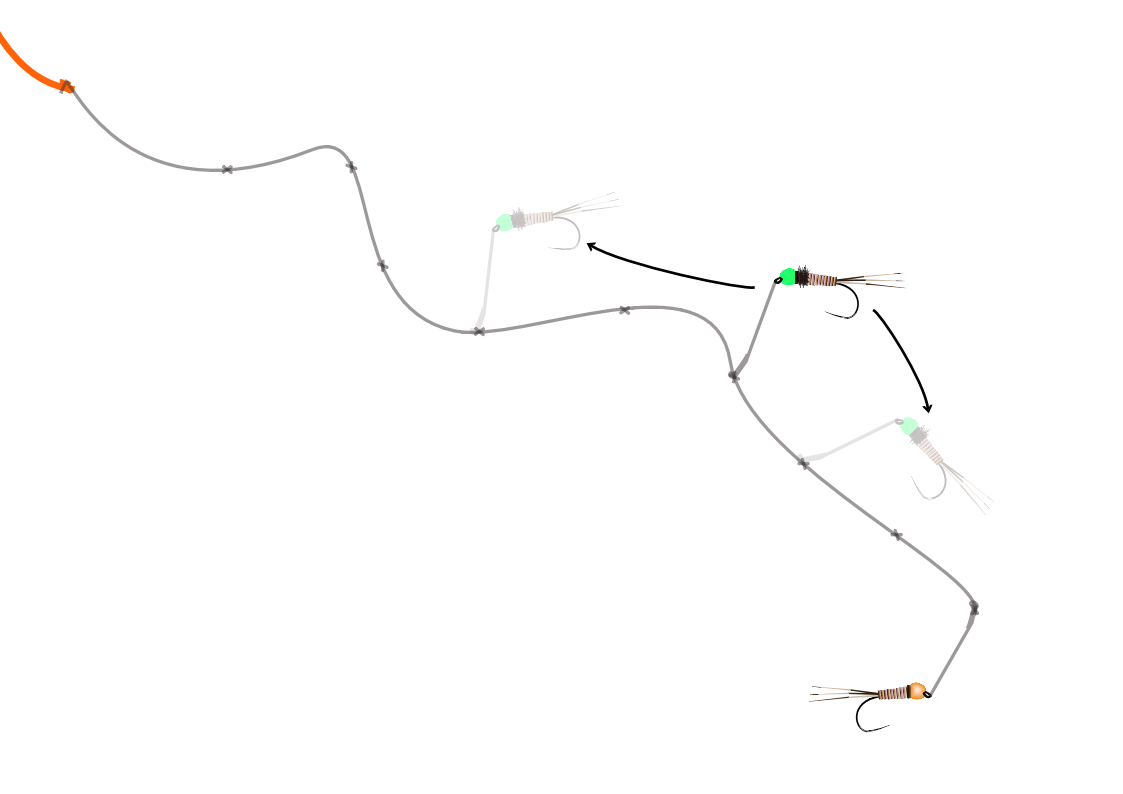
Short-line Czech Nymphing example of a Ladder Leader Rig (with quick-change dropper spacings)
Ladder Leader Droppers: Basic
The most basic form of dropper for your ladder leader rigs is to attach a fly to a section of tippet and then tie a figure of eight loop the opposite end.
This should be nylon/copolymer and anywhere between 0.11 mm and 0.16 mm diameter material.
I recommend 4” (10-cm) droppers which combines good take detection with adequate separation from the main stem. These are shown in the "First Ladder Leader Dropper Idea" diagrams above
The use of a loop-tying tool will help to make those droppers a consistent length. It is possible to store these ready-mounted flies in a regular fly box or fly wallet - but as you’ll see there are also some neater solutions too.
Before we get onto those, I want to flag up that Vladi Trzebunia’s swivelling droppers used a perfection loop. We prefer a figure of eight - especially in fine tippet - to preserve greater strength. If you’re worried that a dropper of only 4” (or even 6”) is too short to fool fish when your fly is so close to the thicker fluorocarbon, remember that many advanced bait fishing rigs use hook links of the same length. Those methods are using tiny hooks for extreme finesse presentations.
To attach a dropper to your leader, just follow the diagrams above which show you a neat way to use a modified loop-to-loop style process to create a girth hitch.
Bunny Ears (quick change tags)
One of the first refinements I made to the basic dropper design was to add tiny “tags” that you can pull on to loosen girth hitches. These use the same mechanics as found in “transition loops” used to attach tenkara lines to the tips of tenkara rods. It is also common to pole rigs used in coarse fishing – so these are all yet more examples of the benefits of cross-training in different angling skills. I'll expand on the details of these in my nymphing book - and we'll also cover them in our video publications too.
Special “Ready to Rock” Storage Systems
I can see this deluxe option as being very helpful for anyone who struggles to thread flies onto tippet due to their eyesight. The good thing is that virtually all of the process is taken care of in preparation at home. You can do this in good light, using a big magnifier if necessary.
You could even bribe someone else to do it for you!
Kit that you’ll need (on top of your pre-tied droppers - each with their fly attached), starts with a reel of Schirring Elastic from a sewing/dressmaking shop. This is available in a range of colours - so go wild. You’ll also need coarse anglers’ hook-link storage box carrying a rack of winders (as pictured).
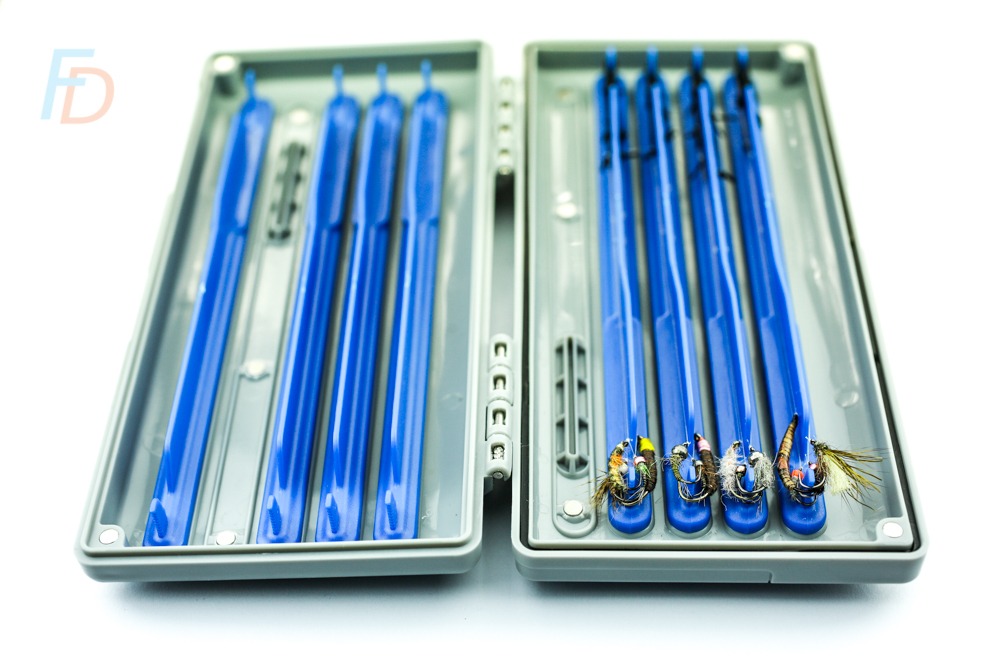
If you’re an all-round angler, you’ll probably have one of these that you’ve used all the hook links from already!
Other Uses of the Ladder Leader
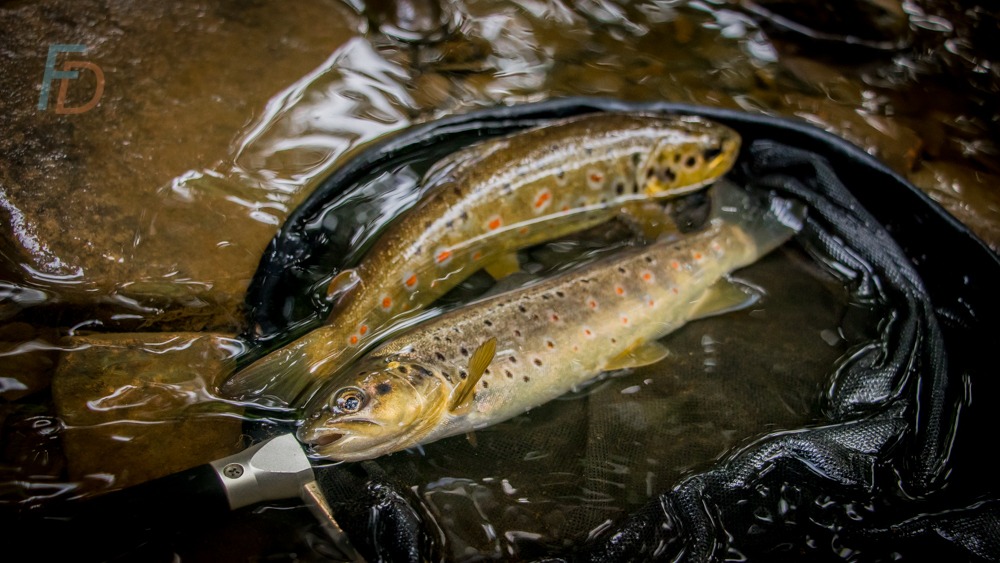
"Double Trouble" landed on a Trio rig - fished on a Ladder Leader Setup
Another of the best applications of this idea has been to fishing the “trio” as proven in the picture above!
This is an extension of the “duo” or “hopper/dropper” tactics). Basically, there are two nymphs attached below the dry fly in a trio rig...
Depending what stage the hatch is at, it is advantageous to have the dropper fly (which can be a nymph or a soft-hackle wet fly actually) fishing higher or lower in the water.
The ability to move the position of that dropper easily is a great advantage.
NOTE – you’ll need to use abrasion-resistant Co-Polymer mono (and NOT fluorocarbon) for this version of a ladder leader. Fine fluorocarbon (of less than 6lb breaking strain) has terrible resistance to abrasion or wind-knots. Putting stopper knots in that fluorocarbon as a main-stem of your ladder leader would be disastrous.
I’m researching and including lots of extra details on ideal leader materials in the nymphing book (↓↓↓ subscribe ↓↓↓ to nymphing tutorials to be notified of book launch):
Imagination is the only limit
This basic idea will also have many cross-discipline applications. For example in lure fishing it can really up your options for drop-shotting set ups.

A lovely perch caught on a drop-shot rig
It's a perfect example of our Fishing Discoveries philosophy in action. Even when you want to become super-specialised, many of the best solutions only occur to you when you have experience of other fishing styles.
Share your Ladder Leader Experiences
Please comment below with your own ladder leader experiments and results – we’re constantly evolving and refining our approaches, so we’d really value your input.
Paul


Hi Paul great that you share some of good ideas on line. Thank you. Your ladder leader idea looks very interesting and I think I will give it a try. I’m just wondering though with all of the extra knots in the leader and loops in the dropper tags when compared to leaders made with surgeons knotted dropper tags do you find any noticeable differences in micro drag or other aspects of performance ? Look forward to hearing your insights. Many thanks Alex.
H Alex,
That’s a great question and there will undoubtedly be some effects (with rig and fishing method selection you are always trading off costs/benefits compared to alternatives).
For the short-line nymphing variant I’m usually using it in fairly deep water with good flow – and so my point fly can afford to be a little denser than for fishing calf-deep clear water in high sunshine (and a single tiny nymph on a long leader). In that situation I’m typically using the 7lb fluorocarbon “main stem” ladder leader with multiple stops (just as in the demo video in the supporting book material). The drift quality and sink time is not adversely affected under those conditions, and the benefits of being able to reposition flies relative to each other on very light droppers is usually worth trading off a little more drag on the main stem – however the density of the relatively heavy fluorocarbon is actually pretty good for cutting through the water and maintaining a stable drift).
The other iteration of the ladder leader which I use (as detailed in the book) is for fishing the “Trio”; and in this function I don’t tend to create a full “main stem” with ladder stops throughout the full length. Instead I simply tie a stop at the point I want my dropper and dry fly to fish initially. Then, if I want to change that spacing, I just drop on another fig.8 on the main stem and pull the “bunny ear” tags to jump the dropper over the original knot and slide down to the new one. That way I minimise the amount of knots in the (thinner than the short-line rig) main stem to avoid weakening it unduly – and also minimise additional drag.
Of course, you may find situations where tiny amounts of additional drag are crucial – so you might have to go to a single fly with thinner tippet; but that is just normal for the fishing choices we always make in terms of cost/benefit.
As always, you need to start from the end result/presentation you want to achieve and then work backwards to design the ideal delivery mechanism (which is the combination of your rig and casting/presentation skills).
Best of luck on stream and I hope this makes sense?
Paul
Hi Paul! Thanks for sharing this online, that’s a great idea. Just got a copy of your book, and it is by far the best and most helpful source on the topic at the moment. What kind of sighter material do you use with the ladder leader?
Cheers Stefan
Hi Stefan that is so kind of you – many thanks.
For sighter I often use Rio sighter tippet, though sometimes coloured braid for short-line nymphing.
The main other application I use this approach for (as detailed in the book) is for fishing the “Trio” approach (where the dry fly either on/off the water acts as a sighter as well as a fish-taker).
Paul
Is there a good tutorial on tying the figure of 8 in this setting? Most of the 8s I am aware of are for rope rescue etc
Hi Bryan, it’s just the first part of the process you’d use to tie the climbing rope version (I.e. you don’t then go back and thread the tag end around following the original knot). It’s just the very first stage shown here after the overhand knot demo: https://youtu.be/_0lIkq0PJCs
I’ve been experimenting with the Knut Hitch, (https://youtu.be/4-2t2gzXek8) which is a friction hitch usually used by arborists. It slides up and down on a rope when free, but locks under pressure, it’s a version of the taut line hitch your friendly, neighborhood boy scout use on tent guy lines. The more wraps you add, the more friction you get. It stays put while casting and in the water, but in use with a fish on the line it will end up sliding slowly down until it hits your point fly. Takes a bit of practice and fiddling around to get the correct number of wraps, but trial and error is your friend. You have to work it like you would a clinch knot. The video uses climbing rope, and the piece on the left would be the section of leader that has your fly tied on. It really works quite well once you sort out the kinks.
This is very cool and really interesting Ken – thank you
Paul
what is name of the pre tied dropper fly container
Hi Kirby, the box I use is from Preston Innovations and is designed to be used by bait anglers to store ready-tied hook-lengths. It is part of their mag store range. I’m currently writing up the details of how I modified the rig sticks inside the box to cope with flies on different hook sizes for my book on nymph fishing.
Watch this space for publication progress!
Paul
Hello Paul,
I find this Ladder Leader approach very interesting and anxious to experiment with it. With regard to pre-tyed droppers with flies. I have encountered many situations not knowing which fly to use until reaching a particular watershed. That said, I would imagine one could have on hand some pre-tyed perfection loop droppers with a little extra length without a predetermined fly. That way, one can make their fly choice on the spot per say while still saving time. As for the fo8 at the end of the ladder rig for the point fly, would that connection create a hinge and affect the presentation of the point fly? I was thinking leaving the end of the Ladder leader open and using a blood knot to attach the point fly? Thoughts? BTW, I really love the idea of the Ladder Leader! Best regards.
It’s surprising how many bases you can cover by having your favourite options of flies added to the rig-holder boxes (probably a couple of dozen flies ready to go at any one time).
Regarding the hinge/point fly situation, in practice it works at least as well as a normal dropper – and when you hold it under tension; it behaves very much like a regular point fly as a continuation of the main leader. However, when I use finer co-polymer for the main stem (instead of 7lb fluoro), I often tie the point fly directly to the end of the tippet – simply because I can tie that knot about as fast as I can fix the girth hitch in place.
Thanks for your feedback Ty.
Paul
Interesting Paul.I have been using something very similar for a few years.Use it when tightline nymph a drop shot rig with split shot on the bottom.I have had a few break-offs on the dropper loop.Think it’s when they slide about they get damaged with friction. So tend to use a double fo8 loop on the droppers now.Do you find you get away with 7lb flourocarbon main ladder leader.What diameter is your 7lb flourocarbon.I tend to use lower diameter.Lastly don’t really get your last bit of the leader to bottom fly.Is the loop looped round a fo8 knot
Or is it loop to loop connected to bottom fly.Maybe make a few mods on my rig.Home from work in a few day’s.Will give it a try.Cheers
Hi Robert – for short-line nymphing in “normal” to high flows (i.e. not bare bones/flat, bright conditions), using the 7lb fluorocarbon for the main stem (and either 0.13mm or 0.11mm diameter copolymer droppers) is absolutely fine. I use finer “main stem” copolymer material when I fish methods like the “trio” – and I put fewer stopper knots in it.
For the 7lb fluorocarbon leader “stems” I am in the 0.22 to 0.25mm diameter (depending on brand) and, unlike the trio method where I quite often just tie the nymph to the end of the main stem copolymer, I simply girth-hitch a dropper around a stopper knot that is tied right at the tip of the “main stem”.
I have played around with using small (custom designed) drop-shot weights attached to the bottom of the main stem too (with essentially unweighted/very lightly weighted dropper flies).
There’s a lot of scope for experimentation and variations on the same theme.
Paul
I don’t think i will make loops at home.I have 14cm thumb dressing forceps hanging from a zinger.I can make a loop in seconds.Maybe store working point flies on loops in a tin.(for that day)Then i can just loop different weight point flies on – off all day.I have used bunny ears loops before.It does make it much easier to change them out.Cheers
Thanks Robert – I hope you have fun with your own modifications and experiments 🙂
Paul
Liking this Paul. I tried something similar on one of JT’s hosted winter Grayling trips to the R Clyde a few years back, having become fed up with losing heavy point flies. I had one of those “wheels” of split shot in my bag. At the end of my short line nymphing tippet (maybe 0.14mm; big winter river) I tied a sacrificial “dropper” (maybe 0.10mm) with a stopper knot at the end, then added split shot ‘til I was bouncing along the bottom. My bottom fly was then a few inches above the riverbed. I didn’t catch any Grayling, but I didn’t lose any more point flies!😀
Good stuff – thanks for the feedback Andrew and I hope you get among some nice grayling this winter,
Paul